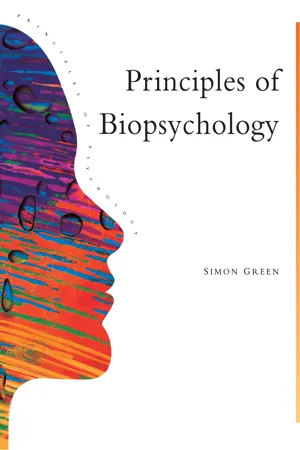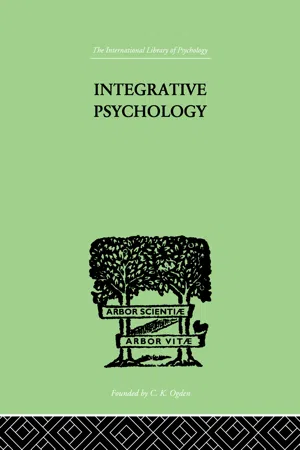Psychology
Sensation
Sensation refers to the process of detecting and receiving information from the environment through our sensory organs, such as the eyes, ears, skin, nose, and tongue. It involves the initial conversion of physical stimuli into neural signals that can be interpreted by the brain. Sensation is a fundamental aspect of perception and plays a crucial role in how we experience and interact with the world around us.
Written by Perlego with AI-assistance
Related key terms
6 Key excerpts on "Sensation"
- Nancy Fenton, Jessica Flitter(Authors)
- 2015(Publication Date)
- Research & Education Association(Publisher)
Chapter 6 Sensation and PerceptionWhat does one know about his or her world? Since the beginning of scientific psychology, psychologists have been interested in understanding Sensation and perception and how these two interconnected processes relate to cognition and behavior. Psychophysics , a branch of psychology strongly influenced by German scientist Gustav Fechner , studies how physical stimuli (Sensations) translate to psychological experiences (perceptions). Sensation involves how an organism receives stimuli and information from the surrounding world via the sensory organs. Psychophysicists investigate the human senses, including vision, audition (hearing), gustation (taste), olfaction (smell), somatic (touch, temperature, pain), vestibular, and kinesthetic. Each sense has specific receptor cells located in the sense organs, which transform physical stimuli into neural impulses in a process known as transduction . The complementary process to Sensation is perception , which involves the interpretation of Sensations. Perception includes the cognitive processes of receiving, encoding, storing, and organizing Sensations.STUDY TIPBe able to distinguish between the processes of Sensation and perception .ThresholdsHow intense does a stimulus have to be to produce a Sensation? Psychophysicists have answered this question with absolute thresholds , or the minimum intensity of stimulation needed for detection 50 percent of the time. For example, an experimenter attempting to find an individual’s absolute threshold for sound may walk away from the individual with a ticking watch. As soon as the individual cannot reliably hear the watch 50 percent of the time, the experimenter has determined that individual’s approximate absolute threshold for sound.A subliminal stimulus is a weak stimulus presented below threshold that cannot be consciously registered. Research has questioned if very weak or quick stimuli below one’s level of consciousness can be interpreted; this is known as subliminal perception . Although subliminal commands to change behaviors have not been confirmed, there is some evidence that subliminal stimuli may have a subtle influence on behavior, but the influence is neither strong nor long-lasting. Any claims by advertisers that subliminal messages can change complex behaviors, such as ending addictions or learning a new language, are not- eBook - ePub
- Ann L. Weber, Joseph Johnson(Authors)
- 2011(Publication Date)
- Collins Reference(Publisher)
CHAPTER 5Sensation
B asically everything we know about the world comes to us through our senses. These include vision, audition, the skin senses such as touch and sensitivity to heat and cold, the chemical senses of taste (gustation) and smell (olfaction), as well as internal senses dealing, for example, with nutrient and salt levels of the blood and the angles of the joints (proprioception).BASIC PRINCIPLESEach sensory organ (for example, the eye, ear, skin, nasal passage, or tongue) and its corresponding information pathway is uniquely structured to receive a particular form of physical energy, translate it into the electrochemical energy of neural impulses, and transmit this information to the brain. The field of psychophysics (see also Chapters 1 and 6) has taught us a great deal about how physical energy is related to psychological experience. First, we cover here some principles that apply across sensory modalities, before examining each sense in more detail.From Physical to PsychologicalThe first step for any sensory modality is the transformation of physical signals into neural signals, the language of the nervous system; this process is called transduction . For example, the ear and auditory system turn physical vibrations into psychological sounds, while the eye and visual system turn physical light into psychological images. Each sensory system is equipped with specialized receptors (sensory neurons) that detect a particular form of energy or chemical. Sensory neurons are essentially the first link in the chain of sensory information, receiving signals from the physical world rather than via dendrites from other neurons. Furthermore, receptors and other neurons have specific receptive fields - eBook - ePub
- Simon Greene(Author)
- 2013(Publication Date)
- Psychology Press(Publisher)
10 Sensory SystemsIn Chapter 2 , I mentioned briefly the role of sensory receptors in converting stimuli from the outside world into action potentials in the axons of sensory neurons. The range of receptors we possess defines what sort of world we live in, as we can only respond to and be aware of stimuli that our receptors can convert into action potentials.We can reverse the argument and consider what types of Sensations humans can deal with; then, by definition, we must have sensory receptors adapted for those stimuli. One group are the somatic senses of the skin and body, including touch, pressure, vibration, tickling, temperature (warm and cold), and pain. Then there is proprioception, the awareness of the position of our limbs and body in space. Smell (olfaction) and taste (gustation) have similarities as they both involve chemical stimuli, while our most sophisticated and complex senses are sight (vision) and hearing (audition).Each of these systems has the same components. Sensory stimuli are converted (transduced) by specialised receptors into action potentials in sensory axons heading into the central nervous system (afferent pathways). After traversing several synapses they arrive (usually) in cortical receiving areas for high level analysis, where Sensation (simple awareness of a stimulus) becomes perception (awareness of complex stimulus properties). Of course there is great variation in the nature of the receptors, the distribution of the pathways, and in the precise cortical areas involved.Much of the detailed work on sensory systems is beyond the scope of this book. I will briefly review the somatic senses, proprioception, smell and taste, and then deal with pain perception in more detail. Most of the chapter will concern hearing as this, along with vision, is the system on which we rely most.Somatic SensesIf you imagine the range of stimuli you can feel on your skin, then you are imagining the range of our somatic senses. Some seem to be related—light touch, pressure, tickling etc—and some seem very different—pain, heat and cold. Those related to touch involve mechanical pressure on the skin. This produces movement of the skin surface, and this is picked up by sensory receptors beneath the surface. Changes in skin temperature are also sensed by specialised receptors. The perception of pain can be produced by all sorts of stimuli, as it depends in part on stimulus intensity rather than type; pinching, jabs with a sharp instrument, extreme heat or cold, can all lead to a feeling of pain along with the Sensation of being hit or of being hot or cold. - eBook - ePub
Integrative Psychology
A STUDY OF UNIT RESPONSE
- Marston, William M & King, C Daly & Marston, Elizabeth H(Authors)
- 2020(Publication Date)
- Routledge(Publisher)
However, it would still seem that behaviouristic theory is responsible in large part for the confusion that allows it to be supposed that Sensation can be described either by descriptions of part-reactions that are not psychonic or by descriptions of total responses which, as units, are not conscious. To sum the matter up, it is the conscious experience of Sensation that is the common element by an appeal to which alone sensory experiments can be conducted. If we wish to deal with this common element objectively, we shall be dealing in fact with a psychonic part-reaction of the given unit response, and only with that psychonic part-reaction that takes place within the sensory sub-division of the organism in question.Sensation as Viewed Physiologically.
Aside from the strict behaviouristic denial of Sensation as such, almost all other theories of Sensation may justly be termed physiological. The ordinary list of the five senses, which was never fully comprehensive, has long since been done away with in favour of more physiological tabulations. There are a great many such physiological lists in existence, and the following may be taken as a typical example :Skin Sensations : Touch Warmth Cold Pain Kinaesthetic Sensations : From Joints Tendons Muscles Taste Sensations : Salt Bitter Sweet Acid (also perhaps metallic and astringent) Auditory Sensation Equilibrium Sensation Visual Sensation Olfactory Sensation Also pain Sensations not cutaneous, i.e. not originating in the skin Hunger Sensation Thirst SensationThere are, of course, other types of list not physiological in character, since, in order to arrive at them, one need never have heard of an end-organ or a nerve. We append such a list for comparison with the physiological one just cited :Auditory Sensation Visual Sensation Olfactory Sensation. Gustatory Sensation Tactile Sensation Kinaesthetic Sensations : i.e., Sensations of movement, either of the whole organism or of any of its parts. Coenaesthetic Sensations : Including all Sensations resulting from stimuli originating within the organism, e.g. hunger, thirst, equilibrium, muscular tension, etc. - eBook - ePub
- (Author)
- 2012(Publication Date)
- Wiley(Publisher)
Fortunately, a broad overview shows that it is possible to see some unifying perspectives that have evolved through the history of the study of perception and are not bound to any single sensory modality. This seems to have been recognized by many researchers in this area, since it is not uncommon for them to do research on several sensory systems at the same time. Thus, we find Helmholtz and Hering studying both vision and audition, and Georg von Békésy, who won the Nobel Prize for his work on hearing, also did research on vision and touch. When it comes to theorists, Fechner, Stevens, Ames, Gibson, Wertheimer, Koffka, Helson, and others have presented frameworks, models, and mechanisms that are virtually modality independent, and can be tested and applied to vision, hearing, or any other sensory system. This is not to deny that there are issues that are important to particular single sensory modalities that do not generalize. For example, the chain of events that leads from the absorption of a photon to a visual neural response and ultimately to a conscious recognition of the stimulus seems to be unique to vision. Instead, I am suggesting that there are global theoretical and methodological frameworks that encompass all sensory and perceptual research. To refer back to that very specific issue of visual detection, while the mechanism of how a photon is captured is specific to sight, all sensory modalities must deal with the idea of detection, which includes the idea of sensory thresholds and their relationship to what the individual consciously perceives. It is also likely that the higher level decisional processes, where the observer must decide if a stimulus is there or not, will be the same whether one is dealing with vision, audition, olfaction, or any other sensory system. Thus, we find that there are certain common issues and definitions that cut across all sensory modalities. These methods, philosophical foundations, and psychological understandings have undergone a steady evolution during the history of this area of psychological research.This chapter is written as an overview and concentrates on some general themes, rather than on the data and findings from any one sensory modality. From this, hopefully, some idea of the context and scope of the study of perception, and its relationship to other aspects of psychology and other sciences, will emerge. Three global issues will reappear many times and in several guises during this history. The first deals with the perceptual problem, which is really the issue of the correspondence (or noncorrespondence) between our internal representation of the environment in consciousness and the objectively measured external physical situation. The second has to do with the borrowing of methods, viewpoints, and theoretical formulations from other sciences, such as physics and physiology. The third is the distinction between Sensation and perception, which is really the distinction between stimulus-determined aspects of conscious and interpretive or information-processing contributions to the conscious perceptual experience.The Perceptual Problem
We must begin our discussion with some philosophical considerations. This is not merely because all of science began as philosophy, nor because up until the middle of the 20th century, philosophy and psychology departments were often combined as the same academic entity in many universities. The reason that we begin with philosophy is because it takes a shift in philosophical viewpoint to justify why we need a psychological discipline to study Sensation and perception in the first place. Most people have a naïve, realistic faith in the ability of our senses to convey an accurate picture of the world to us. For the proverbial “man on the street,” there is no perceptual problem. You open your eyes and the world is there. According to this viewpoint, we perceive things the way that we do because that is the way that they are. We see something as a triangular shape because it is triangular. We feel roughness through our sense of touch because the surface is rough. Thomas Reid, a Scottish philosopher who will later prove to be very significant in the history of perception, summarized this idea in 1785 when he wrote: - eBook - ePub
- Terry McMorris(Author)
- 2014(Publication Date)
- Wiley(Publisher)
2 Sensation and Perception of External InformationLearning objectives
At the end of this chapter, you should be able to:- understand what is meant by indirect or inferred perception
- describe how information processing theorists explain perception, with particular reference to:
- – signal detection theory
- – nature and role of selective attention
- – nature and role of visual search
- – how individual differences affect perception
- understand what is meant by direct perception
- have a basic knowledge of how ecological psychologists explain perception, including
- – nature and importance of affordances
- – how perception and action interact to detect affordances
- understand the main criticisms of information processing and ecological psychology theories with regard to perception
- be aware of the main developmental factors affecting perception.
In this chapter we examine, from an information processing perspective, how we perceive external information particularly for the purposes of making decisions. From an ecological psychology stand point, we are looking at how perception and action combine to recognize the existence of affordances in the environment. The role of perception in the control of movement is covered in Chapter 6 .Information processing theory, Sensation and perception
Although information processing theorists argue that Sensation and perception are different, the two concepts tend to be treated as one. The senses, which are the most important in the perception of information for decision making, are visual and auditory receptors. Vision is generally considered to be the most important of the senses. Light rays enter the eye through the lens and are detected by the retina. The central portion of the eye, the fovea, is rich in nerve receptors, which allow it to extract detail from an object. The range of foveal or central vision depends on how the eye is focused. This is controlled by the ciliary muscles, which are on either side of the lens. The range is generally regarded as being between 2° and 5°. The vision outside of this range is referred to as peripheral vision. The receptors, here, are less dense and images are less distinct than those found in foveal vision. Although foveal and peripheral vision are commonly used terms, Trevarthen (1968) used the terms focal and ambient vision. Focal vision is identical to foveal vision, but ambient vision differs a little to peripheral vision. According to Trevarthen, ambient vision
Learn about this page
Index pages curate the most relevant extracts from our library of academic textbooks. They’ve been created using an in-house natural language model (NLM), each adding context and meaning to key research topics.





